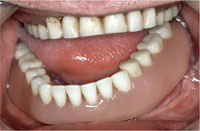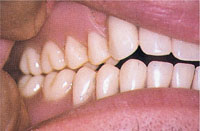Chapter 7
From Trial Dentures to Delivery
Aim
The aim of this chapter is to describe the assessment of trial and processed dentures.
Outcome
At the end of this chapter, the clinician should be able to decide when trial dentures are ready for processing and delivery to the patient. The clinician should be aware of the requirement for balanced articulation, and that occlusal contacts may need to be altered either at the chairside or with a further laboratory procedure. The patient should also be satisfied with the appearance at this stage. It is imperative that if there are any discrepancies, clear instructions to the dental technician are required to rectify problems. It should also be recognised that after delivery of complete dentures, patients should be provided with clear instructions for the immediate post-delivery stage and given clear instructions on how to clean their dentures. Long-term review is also required.
Assessment of the Trial Dentures
This stage in the denture construction process allows the dentist and patient the opportunity to assess the appearance and occlusion of the dentures prior to processing the bases. If either the appearance or the occlusion of the dentures is unsatisfactory, the problems can be rectified relatively easily at this stage.
The trial dentures should be returned to the surgery on an articulator. The articulated trial dentures should be assessed, and if errors are noted then it is likely that the prescription features of the occlusal rims have not been followed by the technician. The sequence of checks should be the same as the jaw registration stage, starting with the maxillary denture. If the length, position and orientation of the maxillary teeth are correct, these are not changed. The mandibular teeth are then inserted and the occlusion, vertical dimension and freeway space are checked.
Assessment of the trial dentures involves checking the following:
-
Appearance of the teeth – This includes size, shade and arrangement of the teeth. The level and orientation of the occlusal plane should also be assessed.
-
The positioning of the teeth relative to the neutral zone – Is there any instability associated with the labiolingual positioning of the teeth?
-
Is the occlusion balanced? Is there any sign of early contact in centric relation and consequent anterior or lateral slide into the position of maximum intercuspation?
-
Is the freeway space correct?
-
Phonetics.
Appearance
The patient should be asked for their opinion regarding the appearance of the trial dentures. Assure them that at this stage any aspect can be changed. It may also be helpful to leave them on their own for a few minutes or to invite a friend or relative to give their opinion. Minor alterations can be made at chairside, including changes to the arrangement of the anterior teeth or waxing in the necks of teeth to make them look smaller. Occasionally, the patient will request a different mould or shade of tooth and this will require an extra laboratory and clinical stage. The position of the centre lines should be checked, and if incorrect, then the correct position should be identified and the teeth reset. Orientation of the occlusal plane should be assessed. If it is not parallel with the alatragal and interpupillary lines, the maxillary teeth should be removed and a new jaw relationship recorded.
Tooth position
The maxillary and mandibular trial dentures should be assessed to see if the positioning of the teeth on the rims adversely affects stability. If the maxillary teeth have been set directly over the crest of the alveolar ridge, then the lower teeth are likely to have been set inside the mandibular ridge. This may cause cramping of the tongue (Fig 7-1) and the mandibular denture will rise easily with gentle tongue movements. A further concern would be that the polished surface of the maxillary denture cannot be harnessed to develop a peripheral seal.

Fig 7-1 Cramping of the tongue. The position of the posterior teeth restricts tongue movement and may destabilise the denture.
In the case of anterior teeth, if these have been set too far forward of the alveolar ridge, instability may be evident. This is seen in patients with a pronounced mental groove or in patients with a very strong mentalis muscle action. If the tooth position is unsatisfactory, the clinician can make minor chairside adjustments by altering the position of the necks of the teeth. If the occlusion is correct, wax can be added to the buccal aspect of the teeth to indicate to the technician how far buccally the teeth should be moved to correct the error. If the occlusion is incorrect, remove the teeth and reshape the occlusal rims to indicate how both errors should be corrected.
Occlusion
Prior to assessing the occlusion, the clinician should determine that the maxillary denture is satisfactory. Assuming that the maxillary denture is correct, then the mandibular denture can be inserted and the occlusion checked. The occlusion of complete replacement dentures should be balanced, and maximum intercuspation of the teeth should be evident in centric relation. The patient should be guided into centric relation and instructed to bite gently until the teeth first contact. The clinician should stabilise the mandibular trial denture by placing the index fingers on the buccal aspects of the trial denture. If the teeth meet evenly (assuming the freeway space is correct), and the denture teeth slide freely without locking in lateral excursive movements, then the occlusion of the trial dentures is deemed satisfactory. Errors (e.g. Fig 7-2) which may be evident at this stage are:
-
There is early contact with a slide in an anterior or lateral direction. This should be suspected if teeth are displaced from the maxillary trial denture. The most likely cause of this is a jaw relationship registration error. This can be confirmed by checking the trial dentures on the articulator – if the teeth meet evenly on the articulator then a jaw registration error should be suspected. Very minor errors may be corrected at the denture delivery stage, as will be discussed later. If a gross error is noted, then the posterior teeth on the mandibular denture should be removed and the jaw relationship re-registered.
-
There is either a unilateral or a bilateral posterior open bite. In this case, either the level of the teeth in contact is too high, or the teeth out of contact are set too low. If there is too little freeway space, then the problem lies with the level of the teeth in contact. These teeth should be removed, wax should be added to the rim and a new jaw relationship recorded. If the freeway space is correct, then wax should be added to the teeth in the area of the open bite and a new jaw relationship recorded.
-
There is an anterior open bite. Assuming that the aesthetics of the maxillary denture are acceptable, then check the freeway space. If there is too little freeway space, then the posterior teeth are the cause of the problem, and the lower posterior teeth should be removed and a new jaw registration recorded. If the freeway space is correct and the level of the mandibular anterior teeth is too low, then wax should be added to the anterior teeth to indicate the correct level. The trial denture can then be returned to the dental technician to alter the level of the anterior teeth. A further possibility is to adjust the level of the anterior teeth at the chairside.

Fig 7-2 An occlusal error evident in trial dentures: posterior teeth meeting too early in centric relation.
If temporary bases have been used, the adaptation of these bases to the underlying tissues should be checked when assessing the occlusion. It is possible that an occlusal interference will displace the bases away from the tissues and give the impression that the teeth meet evenly. This is best checked by placing a flat plastic instrument between the teeth when they are in occluding contact. If the bases are poorly adapted, then a space will appear between the teeth when depressed by the instrument. If this was overlooked at the trial denture stage, then an open bite will be evident on the processed dentures.
Freeway space
The amount of freeway space should be checked by measuring the occluding face height and the resting face height. In addition to measuring the freeway space, the clinician should also assess this visually. If there is too much tooth showing, or if the patient is struggling to put their lips together, there may be insufficient freeway space. The patient should be asked to speak and if their speech sounds incorrect, this may also indicate that there/>
Stay updated, free dental videos. Join our Telegram channel

VIDEdental - Online dental courses


